Violectric DAC V800
Two channel high-end digital-to-analog converter review
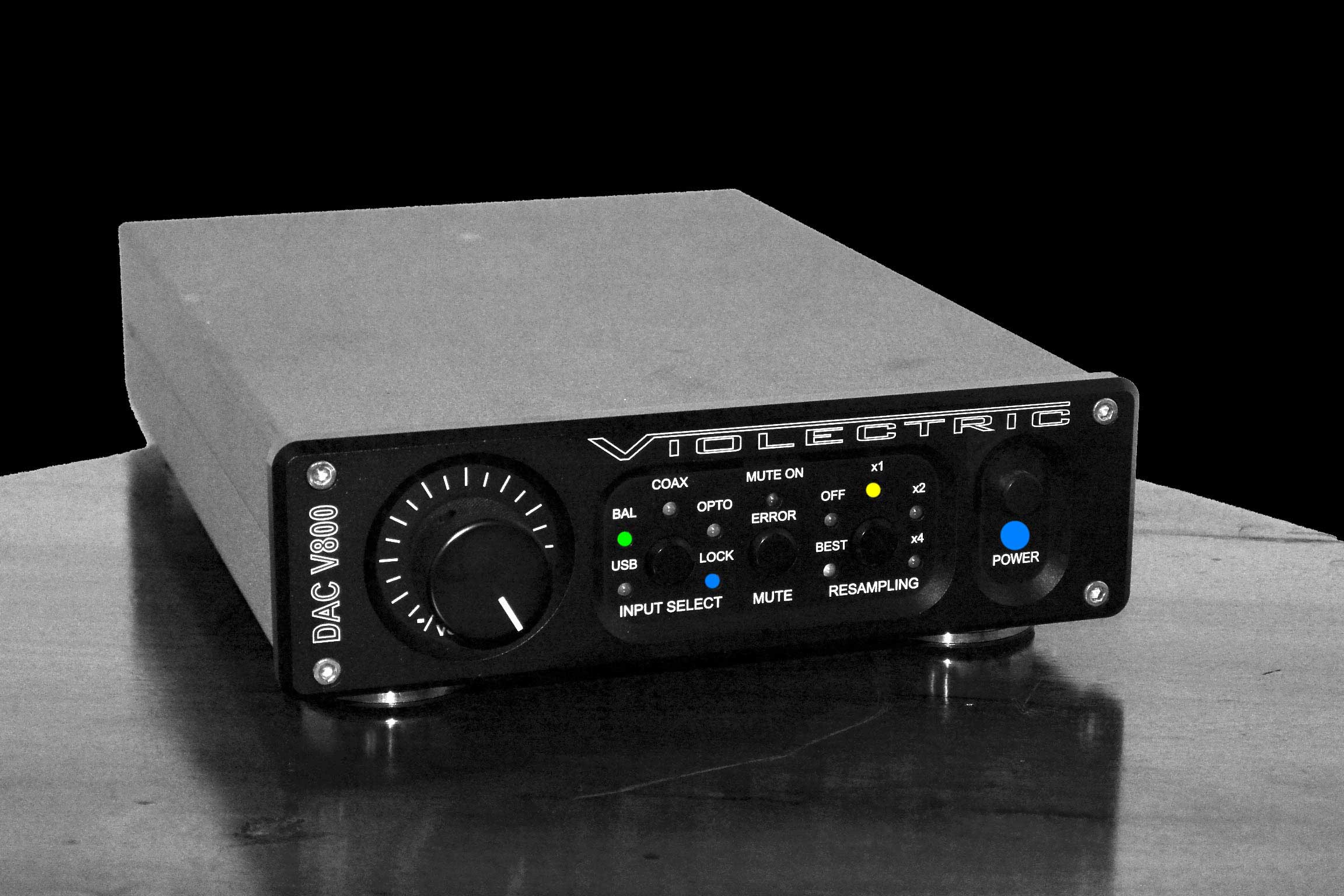

Introduction
Having reviewed the excellent Violectric’s HPA V200, this time we would like to focus on DAC V800 that has become our reference DAC in our mastering studio. For those of you who still don’t know, Violectric represents a branch of Lake People, a German company that has operated for more than twenty years in the professional audio industry.
The Violectric brand was created to commercialize, in the consumer market, a range of high-level products which also included digital-to-analog converters. During our stay at the Denver CanJam we got to have a long talk to Fried Reim Violectric’s CEO. Its design and technical philosophy are very simple but also very effective. Violectric products, in particular headphone amplifiers, are characterized by a very low noise, low internal gain, a very high output voltage for high impedance headphones and a very high power output for low impedance headphones. A high damping factor ensures a flat frequency response for any headset. With the creation and marketing of the V800 DA converter, Fried Reim wanted to apply the same concepts of simplicity and technical excellence to the world of digital-to-analog converters. The world is full of different solutions, some of which are better than others, that have invaded the market thanks to the success of liquid music where the listener uses a computer as his own music source.
Design and operation
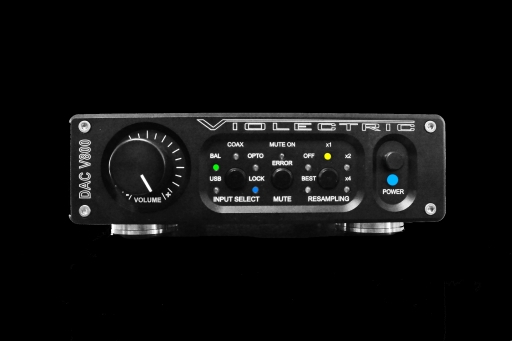
The DAC V800 has a very solid construction and very compact dimensions. External chassis invokes the colors and materials of the HPA V200 headphone amplifier. As you can see from the pictures, this DAC is covered in buttons, connectors and LEDs. On the rear panel there are: the balanced digital AES/EBU input, a TOSLINK optical input, a S/PDIF coaxial digital input and of course the USB connection. This one is characterized by the Tenor TE7022L USB receiver that enables the use of audio files with a maximum resolution of 24–bit / 96 kHz. In addition to balanced and unbalanced analog outputs there’s also a coaxial digital output where the signal is completely regenerated by the DAC’s internal clock with a significant lowering of the jitter values. This signal can then be sent to other devices with a coaxial digital input. On the front panel we have the signature blue power button typical of Violectric, a button that allows you to select the type of digital input, as well as another key that allows you to mute the analog outputs of the DAC, and a button that lets you select resampling mode of incoming signal from x1, x2, x4, BEST or OFF. Particular attention should be paid to the volume control that operates entirely in the digital domain. In this regard we can report what Mr Reim told us:
Some words about digital volume control. The benefit of digital volume control at first glance is, that there will be no more scratching, there will be no channel mismatch, there will be no crosstalk issues. Digital volume control can be made with up-down buttons or incrementals or real potentiometers like Violectric does. In that case a linear tapper is used, because the volume control itself is made dB linear inside the D/A converter. As this mirrors a real life feeling only imperfect when turning the potentiometer, we added some resistors to bend the responding law from the potentiometer to have a nearly perfect analog feeling. A simple DC voltage is attenuated by the potentiometer. The result is fed to an A/D converter, here a digital control signal is made to attenuate the digital audio signal inside the D/A converter before converting it to analog.
A digital 24 bit signal represents a dynamic range of 144 dB much more than can be found in real life. People who are doing real world recordings can tell, that it is nearly impossible to record more than 60 dB dynamic range with a microphone —although microphone makers claim dynamic ranges from their mics to be more that 130 dB. This may be true when recording a cricket near a starting F-14 Tomcat. But who needs that? Also, sitting in your living room, it is hard to follow dynamic ranges of more that 20 or 30 dB unattenuated without having trouble with your neighbors afterwards. Todays pop music dynamic range is reduced during recording to 2 or 3 dB. Please also note that harmonic distortion inside the signal cannot be smaller than the dynamic range.
It is not possible to have 100 dB THD (0,001%) with 90 dB dynamic range. But it is possible to have 110 dB THD (0,0003%) with 120 dB dynamic range. The CD format offers 16 bit which means a dynamic range of 96 dB and distortions which cannot be lower than 0,0016%. A 24 bit signal offers a dynamic range of 144 dB with theoretical minimum distortions at 0,00001%. This is not possible to achieve in real life. The best AD converters today offer dynamic ranges from 120 dB with distortion figures about –110 dB THD. Lots of losses have to be faced during recording, editing, mixinh and mastering. Digital attenuation is done by shifting the signal from MSB to LSB. Shifting a complete bit in LSB direction (and replacing it with a 0) means 6 dB of attenuation. When a 16 bit CD signal is input to a 24 bit DA converter, this signal may be attenuated by 6 dB x 8 bit = 48 dB = factor 200:1 without changing anything from the original data. We also learned that a real 24 bit signal carries a maximum of 20 senseful bits —in practice there are no more than 18 bits. So, also a 24 bit signal may be attenuated by a minimum of 6 dB x 4 bit = 24 dB = factor 35:1 without doing any harm to the original data.
So, in our opinion, digital attenuation is the best thing that can happen to a signal (except not being attenuated). Of course provisions should be made to adapt different working levels in the audio chain. It makes no sense to have a DA converter which offers its technical data only when dramatic amounts of output voltage are present on its outputs. And because you need only 1 or 2 of these Volts you are forced to always digitally attenuate the signal in advance. The maximum output level from a DA converter should be adjusted in the analog make–up circuitry between DA chip and output sockets without changing output impedances and without using special measuring equipment. Afterwards, attenuating the signal digitally will not be an issue at all. Just think of your analog setup: source, preamp, power amp, speakers. The ideal analog chain can mirror a dynamic range of about 130 dB. Your amp, offering 100 W RMS, will reduce this dynamic range to a maximum of 100 dB as it has 30 dB gain always (!) whether you need it our not. Think of the volume control from your pre/amp. What is the maximum position you are using when you’re alone? If it is 12:00 you will again limit the abilities from your analog system by another 20 – 30 dB! If it is 3:00 you will cut only around 10 dB.
As you can see, every analog system is far away from the ideal performance but it seems that nobody cares about that since we are used to it. But ugly, ugly bit cutting is damned because it seems to be obvious that the signal is harmed. Yes, it is harmed but this happens in regions where there is no content! Please keep in mind that we are talking about 24 bit. A 16 bit signal, treated with digital attenuation will definitely be harmed!
Mr Fried Reim has very clear ideas about the subject in addition to a lot of experience and knowledge in order to support his theories. In this regard, having the V800 in our mastering studio, we keep the volume control knob to the maximum level in order to avoid further loss of dynamic or quantization noise.
Listening test
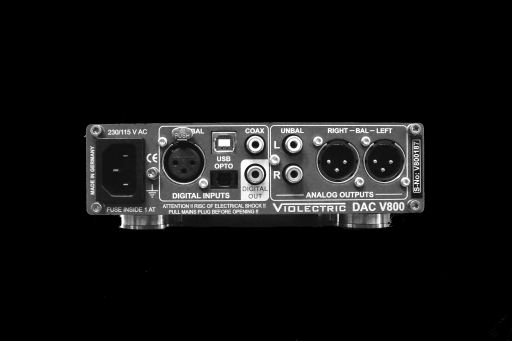
The listening tests held inside of our studio. Due to the V800 USB port being limited to 96 kHz and not allowing use of signals at 88.2 and 192 kHz, we proceeded to use the Matrix Audio X-SPDIF to convert USB to signal AES/EBU. The USB signal from our audio workstation has been filtered and powered with dedicated equipment. The V800 Violectric stock power cable has been replaced with a custom one that performs better. Before we speak of our listening impressions I would like to mention what Fried Reim told us about his manufacturing and sonic philosophy:
I think that the V800 follows the Lake People / Violectric standard: no sound. In my opinion the D/A converter (the chip itself) makes no sound, and (nearly) all modern delta-sigma types are similar. There are older converters like the famous Burr-Brown PCM63 representing the R-2R principle which offer a more specific sound. Sound is made in the analog circuitry following the converter. Here you can find filters and different topologies of output stages. We have made great efforts to create an analog output circuit which is very dynamic, very fast and very noiseless. In addition, the absolute output level can be altered in an active way to match the DACs output level to the subsequent equipment, without altering the frequency range or the output impedance or anything else. If you look at the technical data from —even very expensive DACs— you will discover that many of them use TI/Burr-Brown PCM 1792/1794 or DSD 1792/1794 which are equal in terms of the converting technology.
These converter chips offer up to 132 dB dynamic range in mono mode and up to 127 dB dynamic range as stereo converter. THD+N is down to -108 dB. As you might know, it is very difficult to translate this technical data through a couple of op-amp or discrete output amps. When connecting 2 or 3 op-amp together, these will dominate the technical data. These are the limitations and not only ours. When we thought about how to transport a maximum of the DACs specs to the outputs and not to get lost at -100 or -102 dB THD+N like in normal equipment. We came across the input circuitry from our ADC product. This instrumentation amp design has grown during the past 20 years and is known as a very dynamic, variable and noiseless design with very low THD+N figure (-109 dB!). The error amp from the ADC was turned into a DC removal circuitry for the DAC and the potentiometers for level control has been replaced by DIP-switches for precisely adjusting the analog level. Well, there was some more work… but the result was 120 dB dynamic range, -112 dB THD, -106 dB THD+N.
As described by Mr Reim, the V800 has the DIP-switches inside thereby allowing the output volume of balanced and unbalanced lines to be adjusted. The default output is at +15 dBu representing a 4.5 Volt RMS voltage which may exceed the capabilities of many audio devices designed for voltage swings of 1 or 2 Volts RMS. Hence the presence of the internal DIP-switches that allow you to adjust the output volume from a minimum of +6 dBu to a maximum of +24 dBu. When describing the DAC, we focused on the function of the resampling button. The resampling function is a powerful feature for the regeneration and transformation of audio signals suffering from jittering in high quality signals. Technically, jitter is a temporal inaccuracy in clock signal synchronization which transfers the digital data samples to the DA converter. To move data from one point to another in a digital system, the signal is resynchronized. To make the DAC work optimally, a new stream of data must be presented to the converter at a regular or fixed frequency. One way to make this happen is to resample the input signal at a given frequency. Therefore, the resampling engine recognizes the input signal as PCM audio and evaluates the bits found in the digital signal. Later the same module generates the clock signal necessary for further digital signal processing within the unit. In this way, the quality of common frequencies signals of 44.1 or 48 kHz is enhanced by being converted to a sampling rate higher than the input.
Resampling methods offered by the V800 are OFF, x1, x2, x3, x4 and BEST. The OFF function lights up when the resampling function is deactivated. The source is passed to the DA converter without alteration. With the x1 mode the yellow LED indicates you are using the resampling function. The input source is effectively recombined by the internal clock and transmitted to the DAC at the original sampling rate. The x2 mode indicates that the source will be sent to the DAC at twice the original sampling rate. If the input sampling rate exceeds 110 kHz, the unit will automatically return to the x1 mode. The x4 indicates that the source will be sent to the DAC at four times the original rate. If the input sampling rate exceeds 110 kHz, the converter will automatically switch to x1 or to x2 for frequencies above 55 kHz. The BEST mode sends the source to the DAC at a frequency of approximately 90 kHz, which is considered the maximum optimization in modern converters. Throughout our listening test, even with high-resolution sources, we found that the most faithful reproductions were achieved by activating the resampling mode at x1. We also found that x4 or BEST modes were more suitable for older recordings and for 16–bit sources. We agree with Mr Reim on the fact that the V800 returns the sources according to the sonic construction principle of no sound. The Violectric has proved in fact to be neutral, fast and transparent with greater precision and transient articulation when compared to our previous reference —the MYTEK STEREO96 DAC.
The different design philosophies of their respective chips, AKM for MYTEK and TI for Violectric, combined with greater refinement of the analog output stage of the V800, allows it to have a more accurate sonic stamp, a deeper bass extension and articulation than the STEREO96 DAC. Often when a DAC is referred to be neutral, it ends up being included in the list of those DA converters lacking body or who don’t have a well delineated sonic personality. The V800 is certainly not on this list. It does not add or detract anything from the input source, but it simply returns it to the best of its technical capabilities by providing a listening experience that expresses musical content for what it is. We cannot deny that the Violectric V800 needs an adequate running-in time to unleash its full potential. When first listening it may seem a little less accurate and detailed but with the passing of time the performance reaches notable levels. The V800 is a DAC that manages to get every single detail from the source without being emphasized in the higher frequency ranges. The return of voices and of lower frequencies takes place without hesitation. Certainly it’s a product that is perfectly in the middle of the sonic equation. Terms such as boring or impersonal, certainly don’t apply to this appliance. When trying to make a comparison between different digital inputs we detected an almost similar level in performance between the USB and AES/EBU inputs.
It is clear therefore that the V800, like all products of a certain type, must be interfaced with sources and equipment of the same quality in order to reach its full potential. Especially those who use a properly filtered and stabilized power supply which incorporates a balanced configuration at the same time. We liked the way the DAC provided a good amount of energy, body and transparency to our reference headphone amplifiers.
Final thoughts
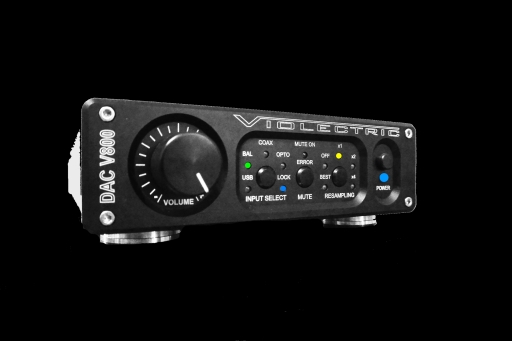
This DAC can be safely combined with a computer or a CD player. It’s definitely a product designed for the consumer and the hi-fi market, but we believe, without a doubt, that all the know-how accumulated from Lake People in the professional audio field has played a decisive role. The V800 can safely perform its role in professional enviroments where a DAC is required to evaluate all-round the sound source. However, with regard to recent products some deficiencies have emerged. We refer to the fact that the USB input is limited to a maximum of 96 kHz thereby excluding the frequencies of 88.2, 176.4 and 192 kHz now increasingly prevalent in high-resolution music tracks. In this regard Mr Reim assured us that Violectric is working on a new USB module that will allow you to take advantage of all frequencies up to 192 kHz and can be easily installed by the user. To conclude if you want a DAC that can do no wrong and which doesn’t subtract any character and body from your source and that shows all the detail as it’s in the original song, then you will definitely love the Violectric V800. Is it worth all the money it costs? For us the answer is yes, especially when you have a reference headphone listening system that makes it possible to appreciate the differences when compared to products of equal cost.
Personal opinion
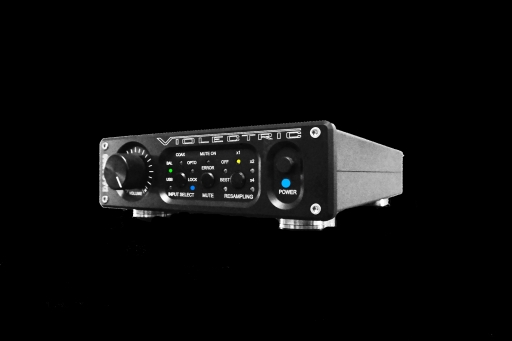
The Violectric V800 became my new reference point and the DAC I trust when I have to test other equipment in my little mastering studio. I consider it a truly remarkable product in its price range especially for professional applications. In my opinion, with the exception of the ESS SABRE and R-2R technology converters, the V800 remains one of the best converter that implements delta-sigma technology. It’s a ranking performer, with a clean and transparent sound, definitely superior to its competitors which are all too often revered and advertised. If you are looking for a product in this price range, the V800 is the one for you.
Score
- Scoring110
- Sound quality [1]
10 - Bang for the buck [2]
8 - Measures [3]
8 - Build quality [4]
10 - Versatility [5]
7 - Overall rating
9
- 1. Sound quality is really great to make it a benchmark in its price category
- 2. Price puts it in the high-end market
- 3. Measures show all the technical know-how of Lake People and Violectric
- 4. Build quality is very high but the aesthetics and design offer room for improvement
- 5. Versatility of the product is pretty good but not at the level of the most recent products








